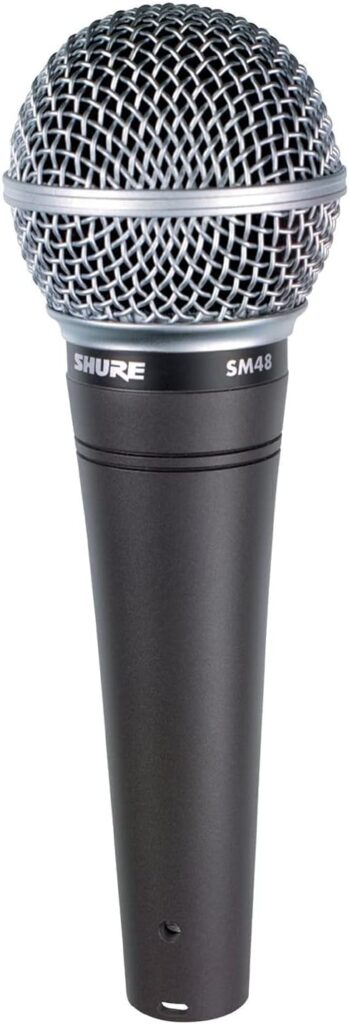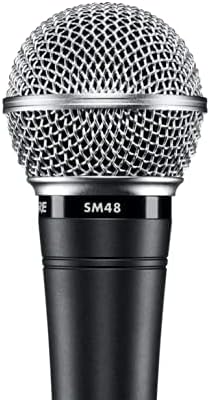Shure SM48 Review
When it comes to microphones, Shure is a name that resonates with reliability, quality, and a legacy that spans nearly a century. Among their extensive lineup, the Shure SM48 stands out as a lesser-known sibling to the iconic SM58 and SM57, yet it’s a microphone that deserves its moment in the spotlight. Designed primarily as a vocal microphone, the SM48 offers a tailored frequency response, rugged build, and versatility that make it a compelling choice for live performers, studio enthusiasts, and even podcasters on a budget. In this review, we’ll explore every facet of the Shure SM48—from its design and sound quality to its real-world applications and how it stacks up against its competitors.
Shure SM48 Review

The Shure SM48 arrives in the brand’s signature no-frills packaging: a simple box containing the microphone, a microphone clip, and a storage pouch. There’s no fluff here, and that’s part of Shure’s charm—they let the product speak for itself. Out of the box, the SM48 feels reassuringly solid. Weighing in at 370 grams (13.1 ounces), it’s hefty enough to convey durability without being cumbersome. The all-metal construction, complete with a steel mesh grille, immediately signals that this mic is built to withstand the rigors of the road.
Visually, the SM48 bears a strong resemblance to the SM58, with its classic cylindrical shape and matte silver finish. However, subtle differences—like the slightly flatter grille design—set it apart. It’s not a flashy microphone, but it exudes a utilitarian elegance that appeals to professionals who prioritize function over form. Included in the package is a basic mic clip, which works fine for most stands but might feel a tad flimsy for heavy-duty use. The zippered pouch is a nice touch for gigging musicians who need to toss the mic into a gear bag without worrying about scratches.
Design and Build Quality
Shure microphones are renowned for their tank-like durability, and the SM48 is no exception. The body is crafted from die-cast metal, giving it a robust feel that can survive drops, bumps, and the occasional tumble off a stage. The steel mesh grille is reinforced to protect the dynamic capsule inside, and while it’s not invincible (a hard enough hit could dent it), it’s more than capable of handling typical wear and tear.
One standout feature of the SM48 is its internal shock-mount system. This reduces handling noise significantly—a boon for performers who move around a lot or for anyone using the mic handheld. Whether you’re gripping it tightly during an impassioned vocal performance or tapping it lightly to emphasize a point in a podcast, the SM48 keeps unwanted thumps and rumbles to a minimum.
The mic also features a built-in pop filter, which helps mitigate plosives (those harsh “p” and “b” sounds) without the need for an external windshield in most cases. It’s not as aggressive as a dedicated pop filter, so for studio recording with close-miking, you might still want an extra layer of protection. Still, for live use, it’s a thoughtful inclusion that enhances usability right out of the box.
At the base, the SM48 sports a standard XLR connector, ensuring compatibility with virtually any audio interface, mixer, or PA system. There’s no on/off switch, which might disappoint some users who prefer that convenience, but it’s a deliberate omission that aligns with Shure’s focus on simplicity and reliability.
Sound Quality
The Shure SM48 is a cardioid dynamic microphone, meaning it picks up sound primarily from the front while rejecting noise from the sides and rear. This polar pattern makes it ideal for live settings where feedback control is crucial. But what really defines the SM48 is its frequency response, which is tailored specifically for vocals.
With a frequency range of 55 Hz to 14 kHz, the SM48 isn’t trying to capture every nuance of the audible spectrum. Instead, it hones in on the vocal sweet spot. The low end rolls off below 55 Hz, reducing muddiness and eliminating much of the rumble from stage vibrations or handling. There’s a gentle boost in the midrange (around 2-5 kHz), which adds clarity and presence to the voice, making it cut through a mix without sounding harsh. The high end tapers off above 14 kHz, avoiding excessive sibilance while still delivering enough detail for articulate speech and singing.
In practice, the SM48 produces a warm, full-bodied sound that flatters a wide range of voices. Baritone vocalists will appreciate the richness in the lower mids, while higher-pitched singers benefit from the controlled presence boost that keeps them audible without piercing the ears. Compared to the SM58, which has a slightly broader frequency response (50 Hz to 15 kHz) and a more pronounced midrange bump, the SM48 feels a touch smoother and less aggressive. It’s not as “in your face” as the SM58, which might make it a better fit for vocalists who want a more natural tone or for applications where subtlety is key.
For instruments, the SM48 can hold its own in a pinch. It’s not as versatile as the SM57 (the go-to for miking guitar amps and snares), but it can handle acoustic guitars, brass, or even a kick drum if you’re desperate. However, its vocal-optimized EQ curve means it’s not the first choice for instrument recording unless you’re going for a specific effect.
Performance in the Wild: Live and Studio Applications
To truly understand the SM48, I put it through its paces in both live and studio environments. First up: a small club gig with a four-piece rock band. Paired with a modest PA system, the SM48 delivered clean, feedback-resistant vocals that sat nicely above the guitars and drums. The cardioid pattern did an admirable job of rejecting stage noise, even with monitors positioned close by. Handling noise was virtually nonexistent, and the built-in pop filter handled plosives well enough that I didn’t miss an external windshield. For a sweaty, high-energy performance, the SM48 proved its worth as a dependable workhorse.
Next, I brought it into a home studio setup, running it through a Focusrite Scarlett 2i2 interface with no preamp EQ applied. Recording spoken word (think podcast-style narration), the SM48 produced a warm, intimate sound that required minimal post-processing. Close-miking at about 2-4 inches revealed a noticeable proximity effect—a boost in bass that added depth without overwhelming the mix. For sung vocals, it captured a folk singer’s performance with a natural warmth, though I did add a slight high-end EQ boost to bring out more airiness for a polished studio sound.
One area where the SM48 shines is its off-axis rejection. In a live setting, this translates to less bleed from nearby instruments or crowd noise. In the studio, it’s great for isolating a source in a less-than-ideal acoustic space. However, it’s worth noting that the SM48, like most dynamic mics, isn’t as sensitive as a condenser. You’ll need a decent preamp with enough gain to get the most out of it, especially for quieter sources.
Compared to the Competition
At around $50-$70 (depending on where you shop), the SM48 sits in a crowded market of budget-friendly dynamic mics. How does it stack up?
- Shure SM58: The SM58 is the industry standard for live vocals, and for good reason. It’s slightly brighter and more assertive than the SM48, with a broader frequency response. The SM48, however, feels smoother and less prone to sibilance, making it a viable alternative for vocalists who find the SM58 too forward. Price-wise, the SM58 is typically $20-$30 more expensive, so the SM48 offers better value if you don’t need the extra punch.
- Sennheiser e835: Another popular live vocal mic, the e835 has a crisper high end and a bit more detail than the SM48. However, it’s also more susceptible to feedback in challenging environments. The SM48 wins on ruggedness and feedback rejection, though the e835 might appeal to singers who prioritize clarity over warmth.
- Audio-Technica ATR2100x-USB: For podcasters or home studio users, the ATR2100x offers USB connectivity and a flatter response, but it lacks the SM48’s durability and tailored vocal EQ. The Shure edges out in build quality and live performance reliability.
The SM48 doesn’t try to be everything to everyone. It’s a vocal mic first and foremost, and within that niche, it delivers exceptional performance for the price.
Pros and Cons
Pros:
- Rugged, road-ready build quality
- Tailored vocal frequency response with warm, clear sound
- Excellent feedback rejection and off-axis noise control
- Affordable price point
- Minimal handling noise thanks to internal shock-mount
Cons:
- Limited versatility for non-vocal applications
- No on/off switch
- Requires a decent preamp for optimal studio use
- Built-in pop filter could be more robust for close-miking
Who Should Buy the Shure SM48?
The Shure SM48 is an ideal choice for:
- Live performers on a budget who need a reliable, feedback-resistant vocal mic.
- Podcasters or streamers looking for a warm, professional sound without breaking the bank.
- Beginner recording enthusiasts who want a durable dynamic mic for vocals or occasional instrument miking.
- Anyone seeking a Shure-quality mic without the SM58’s higher price tag.
It’s not the mic for you if you need the versatility of an SM57, the sensitivity of a condenser, or a USB plug-and-play solution for quick digital recording. But for its intended purpose—capturing vocals with clarity and toughness—it’s hard to beat.
Final Thoughts
The Shure SM48 might not have the fame of its SM58 and SM57 siblings, but it’s a sleeper hit that deserves more attention. It combines Shure’s legendary durability with a vocal-friendly sound profile, all at a price that undercuts many competitors. Whether you’re belting out tunes on a dimly lit stage or recording a podcast in your bedroom, the SM48 delivers consistent, high-quality results without fuss or fanfare.
Is it the best microphone ever made? No—it’s not meant to be. But it’s a damn good one, and for the money, it’s a steal. If you’re in the market for a dynamic vocal mic that punches above its weight, the Shure SM48 should be on your shortlist. It’s proof that sometimes the underdog has just as much bite as the top dog.


